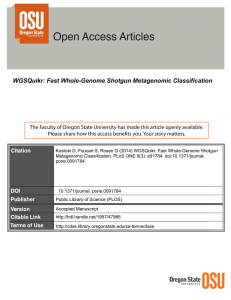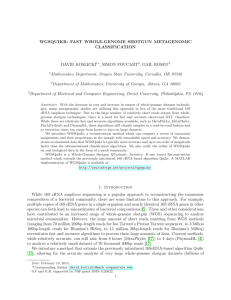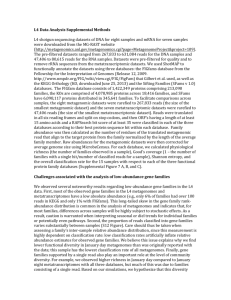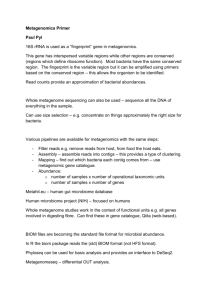WGSQuikr: Fast Whole-Genome Shotgun Metagenomic Classification
advertisement
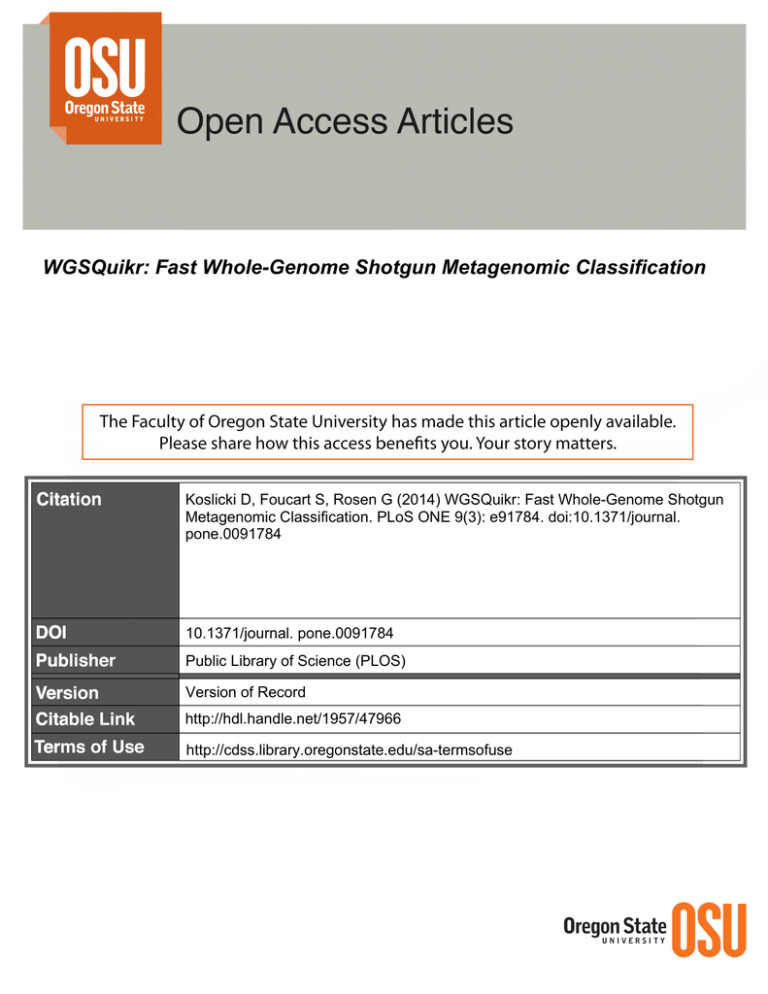
WGSQuikr: Fast Whole-Genome Shotgun Metagenomic Classification
Koslicki D, Foucart S, Rosen G (2014) WGSQuikr: Fast Whole-Genome Shotgun
Metagenomic Classification. PLoS ONE 9(3): e91784. doi:10.1371/journal.
pone.0091784
10.1371/journal. pone.0091784
Public Library of Science (PLOS)
Version of Record
http://hdl.handle.net/1957/47966
http://cdss.library.oregonstate.edu/sa-termsofuse
WGSQuikr: Fast Whole-Genome Shotgun Metagenomic
Classification
David Koslicki1*, Simon Foucart2, Gail Rosen3
1 Mathematics Department, Oregon State University, Corvallis, Oregon, United States of America, 2 Department of Mathematics, University of Georgia, Athens, Georgia,
United States of America, 3 Department of Electrical and Computer Engineering, Drexel University, Philadelphia, Pennsylvania, United States of America
Abstract
With the decrease in cost and increase in output of whole-genome shotgun technologies, many metagenomic studies are
utilizing this approach in lieu of the more traditional 16S rRNA amplicon technique. Due to the large number of relatively
short reads output from whole-genome shotgun technologies, there is a need for fast and accurate short-read OTU
classifiers. While there are relatively fast and accurate algorithms available, such as MetaPhlAn, MetaPhyler, PhyloPythiaS,
and PhymmBL, these algorithms still classify samples in a read-by-read fashion and so execution times can range from hours
to days on large datasets. We introduce WGSQuikr, a reconstruction method which can compute a vector of taxonomic
assignments and their proportions in the sample with remarkable speed and accuracy. We demonstrate on simulated data
that WGSQuikr is typically more accurate and up to an order of magnitude faster than the aforementioned classification
algorithms. We also verify the utility of WGSQuikr on real biological data in the form of a mock community. WGSQuikr is a
Whole-Genome Shotgun QUadratic, Iterative, K-mer based Reconstruction method which extends the previously
introduced 16S rRNA-based algorithm Quikr. A MATLAB implementation of WGSQuikr is available at: http://sourceforge.net/
projects/wgsquikr.
Citation: Koslicki D, Foucart S, Rosen G (2014) WGSQuikr: Fast Whole-Genome Shotgun Metagenomic Classification. PLoS ONE 9(3): e91784. doi:10.1371/journal.
pone.0091784
Editor: Mark R. Liles, Auburn University, United States of America
Received November 12, 2013; Accepted February 13, 2014; Published March 13, 2014
Copyright: ß 2014 Koslicki et al. This is an open-access article distributed under the terms of the Creative Commons Attribution License, which permits
unrestricted use, distribution, and reproduction in any medium, provided the original author and source are credited.
Funding: Funding was provided by NSF grant DMS-1120622. The funders had no role in study design, data collection and analysis, decision to publish, or
preparation of the manuscript.
Competing Interests: The authors have declared that no competing interests exist.
* E-mail: david.koslicki@math.oregonstate.edu
fidelity than any other technique to date, even down to the genus
level.
Briefly, our method first measures the frequency of k-mers (for a
fixed k*7) in a database of known bacterial genomes, calculates
the frequency of k-mers in a given sample, and then reconstructs
the concentrations of the bacteria in the sample by solving a
system of linear equations under a sparsity assumption. To solve
this system, we employ MATLAB’s [5] iterative implementation of
nonnegative least squares and hence we refer to this method as
WGSQuikr: Whole-Genome Shotgun QUadratic, Iterative, K-mer
based Reconstruction. We point out that WGSQuikr has not yet
been optimized for performance but still demonstrates a significant
speed improvement over existing methods.
Introduction
While 16S rRNA amplicon sequencing is a popular approach to
reconstructing the taxonomic composition of a bacterial community, there are some limitations to this approach. For example,
multiple copies of 16S rRNA genes in a single organism and nearly
identical 16S rRNA genes in other species can both lead to misestimates of bacterial compositions [1]. These and other considerations have contributed to an increased usage of whole-genome
shotgun (WGS) sequencing to analyze microbial communities.
However, the large amount of short reads resulting from WGS
methods (ranging from 70 million 200 bp-length reads for Ion
Torrent’s Proton Torrent sequencer, to 3 billion 100 bp-length
reads for Illumina’s HiSeq, to 15 million 36 bp-length reads for
Illumina’s MiSeq) necessitates fast and accurate algorithms to
process these large amounts of data. Current methods, while
relatively accurate, can still take from 8 hours (MetaPhyler [2]) to
4 days (PhymmBL [3]) to analyze a relatively small dataset of 70
thousand 300 bp reads [2].
We introduce a method that extends the previously introduced
16SrRNA-based algorithm Quikr [4], allowing for the accurate
analysis of very large whole-genome shotgun datasets (billions of
reads) on a laptop computer in under an hour. This is facilitated
by leveraging ideas from compressive sensing to reconstruct all
taxonomic relative abundances of a bacterial community simultaneously (as opposed to read-by-read classification). Beyond
significant speed improvements, we demonstrate on simulated
data that this method has, on average, better reconstruction
PLOS ONE | www.plosone.org
Methods
2.1. k-mer Training Matrix
The training step consists of converting an input database of
whole bacterial genomic sequences (with their associated plasmid
sequences) into a k-mer training matrix. For a fixed k-mer size, we
calculate the frequency of each k-mer in each database sequence.
Hence, given a database of genome sequences D~fd1 , . . . ,dM g,
the (i,j)th entry of the k-mer training matrix A(k) is the frequency
of the ith k-mer (in lexicographic order) in the j th sequence dj .
Herein, we consider a single, manually curated database D
consisting of 1,401 bacterial genomes and 1,082 plasmids,
resulting in 2,483 unique sequences, which along with their
1
March 2014 | Volume 9 | Issue 3 | e91784
WGSQuikr: Fast WGS Metagenomic Classification
taxonomic information, were retrieved from NCBI [6] in October,
2012. The bacterial sequences in this database cover 1,109 species
and 614 genera.
2.2. Sample k-mer Frequencies
Given a sample dataset of WGS reads, we orient all the reads in
the forward direction, and then calculate the frequency of all kmers in the entire sample. We refer to this vector s(k) as the sample
k-mer frequency vector.
2.3. Sparsity Promoting Quadratic Optimization
We assume that the given environmental sample only contains
bacteria that exist in the database D~fd1 , . . . ,dM g being utilized.
Hence we can represent the composition of the sample as a vector
x[RM with nonnegative entries summing to one (i.e. a probability
vector) where xi is the concentration of the organism with genome
di . However, as will be demonstrated in subsection 3.10,
WGSQuikr still performs adequately when the sample does contain
novel bacteria not in the database being utilized.
The problem at hand is then to reconstruct the bacterial
concentrations x by solving the linear system (2.1)
Figure 1. Log-log plot of number of reads versus execution
time (seconds) for WGSQuikr, MetaPhyler and MetaPhlAn.
doi:10.1371/journal.pone.0091784.g001
on the randomly chosen bacterial species in each dataset by rerunning each simulation 5 times and observing that the results in
section 3.6 do not change.
2.6. Mock Communities
A(k) x~s(k) :
To benchmark the Quikr method on real biological data, we
examined the ‘‘even’’ mock microbial community (NCBI
SRR172902) developed by the Human Microbiome Project
[10]. This community contains known concentrations of bacteria
from 21 different organisms that span a diverse range of properties
(GC content, genome size, etc.).
Equation (2.1) is solved by using a sparsity-promoting optimization procedure motivated by techniques used in the compressive
sensing literature. Sparsity is emphasized since it is reasonable to
assume that relatively few bacteria from the database D are
actually present in the given sample. We use a variant of
nonnegative basis pursuit denoising [7,8] which reduces to a
nonnegative least squares problem. Unlike the 16S rRNA version
of Quikr [4], WGSQuikr experiences no convergence issues
thanks to the inclusion of an adaptive choice of a regularization
parameter which is calculated individually for each dataset. The
details regarding this procedure are contained in Appendix S1.
Results
There are many whole-genome shotgun metagenomic classifiers
that WGSQuikr can be compared to. A selection includes NBC
[11,12], Phymm [3], PhymmBl [3,13], MetaPhyler [2], RITA
[14], PhyloPythiaS [15], MetaPhlAn [16], Genometa [17] and
MetaID [18].Typically, these algorithms classify a sample in a
read-by-read fashion against a known database. Briefly, NBC
accomplishes this in a Bayesian framework utilizing k-mer counts.
Phymm and PhymmBL use interpolated Markov models to
characterize variable-length oligonucleotides. MetaPhyler and
MetaPhlAn use clade-identifying marker genes. Genometa and
RITA are BLAST-based techniques, and MetaID uses large
common and unique k-mers to classify reads. It has been shown
[2,16,17] that the methods roughly rank in terms of increasing
execution time as: MetaPhlAn, MetaPhyler, PhyloPythiaS,
2.4. Reconstruction Metrics
We denote the actual and predicted concentrations of the bacteria
as probability vectors x and x respectively. The reconstruction
metric primarily employed herein is the ‘1 distance between x and
x : jjx{x jj‘1 . This quantity takes values between 0 and 2 (with
perfect reconstruction being jjx{x jj‘1 ~0) and is commonly
referred to as ‘‘total error’’ (as it is the total of the absolute errors).
The term reconstruction fidelity will be used to communicate
generically how well x approximates x. We will mainly be
concerned with reconstruction fidelity down to the genus level
since the assumption given in subsection 2.3 indicates that
WGSQuikr is applicable in situations where the given metagenomic sample does not contain (too distantly related) novel
taxonomic units absent from the training database. This is more
likely to be the case at the genus level than at the species or strain
level.
2.5. Simulated Data
To test the performance of the WGSQuikr method, the shotgun
read simulator Grinder [9] was used to generate 720 simulated
WGS datasets totaling over 1 billion reads. These datasets have a
wide range of differing characteristics designed to replicate a range
of technologies in a variety of conditions (for example: differing
species abundances, read coverages, read lengths, error models,
abundance models, etc.). The particular parameter values can be
found in Appendix S1. We verified that our results do not depend
PLOS ONE | www.plosone.org
Figure 2. Box-and-whisker plot of execution time (in minutes)
on the simulated experiments for WGSQuikr, MetaPhyler, and
MetaPhlAn. The boxes demarcate 75% quantiles, whiskers demarcate
range, and the vertical black bars are drawn at the mean.
doi:10.1371/journal.pone.0091784.g002
2
March 2014 | Volume 9 | Issue 3 | e91784
WGSQuikr: Fast WGS Metagenomic Classification
nearly constant for WGSQuikr to solve (2.1) via the algorithm
detailed in Appendix S1. This is due to the algorithm taking as
input the k-mer frequency vector, whose size depends only on k,
not the size of the given dataset. This also explains the reason for
the significant speed improvement of WGSQuikr: the entire
sample is classified simultaneously, as opposed to in a read-by-read
fashion such as with MetaPhyler or MetaPhlAn.
Figure 2 shows a box-and-whisker plot of the execution time for
WGSQuikr, MetaPhyler, and MetaPhlAn on the simulated
datasets described in subsection 2.5. Note the significant
improvement in speed: the average execution time of WGSQuikr
is over 6 times faster than the average MetaPhyler execution time.
For the larger datasets (5 M reads), WGSQuikr is on average 27
times faster than MetaPhyler and 5 times faster than MetaPhlAn.
Table 1. Comparison of mean ‘1 -errors at the genus level
(smaller values are better).
Method
Mean ‘1 -error
WGSQuikr
0.644
MetaPhyler
1.006
MetaPhlAn
0.984
doi:10.1371/journal.pone.0091784.t001
Phymm, PhymmBL, NBC, Genometa, and RITA (MetaID [18]
details no run-time data).
WGSQuikr differs from all of these methods as it classifies an
entire dataset simultaneously rather than in a read-by-read
fashion. Furthermore, the other k-mer based techniques typically
use k-mers for k§12, whereas WGSQuikr uses k*7. As
WGSQuikr is intended to be used as a fast classification method
at a taxonomic level in which few novel taxa appear, we choose to
compare to the two fastest methods available: MetaPhlAn and
MetaPhyler. WGSQuikr and these two algorithms will be
evaluated on all simulated data and the mock community using
the default parameters.
3.8. Simulated Data Results
3.8 .1. Reconstruction Error. We evaluated the ‘1 -error at
the genus level on the simulated datasets and summarize the mean
‘1 -error at the genus level in table 1. The histogram in figure 3
shows the ‘1 -error versus fraction of the simulated datasets for
WGSQuikr, MetaPhyler, and MetaPhlAn. Also included is a
smooth kernel distribution approximation of each of the
histograms (shown as lines in figure 3) to emphasize how
WGSQuikr typically has less error than MetaPhyler and
MetaPhlAn.
We hypothesize that the reason WGSQuikr demonstrates such
an improvement in ‘1 -error over MetaPhyler and MetaPhlan is
WGSQuikr’s ability to very accurately reconstruct the frequency
of the most abundant organisms in a sample. Indeed, at the genus
level, the mean ‘1 -error decreased by 31% when focusing on only
the top 10 most abundant genera. See subsection 3.9 for further
supporting evidence.
3.8.2. Reconstruction Fidelity vs Simulation Parameters. In
order to investigate what properties of a given dataset influence the
reconstruction error of WGSQuikr, we grouped the simulated datasets
by each simulation parameter (number of reads, read length,
abundance model, or diversity). Figure 4 summarizes the mean error
of WGSQuikr as a function of each one of these parameters, and
includes the results for MetaPhyler and MetaPhlAn for comparison.
3.7. Speed Comparison
Throughout the following, we fixed the k-mer size at k~7. We
observed the general trend that the algorithm execution time
increased exponentially as a function of k, while the ‘1 -error
decreased roughly linearly. We chose k~7 as this provided a
reasonable tradeoff between fast execution time and low reconstruction error. Figure 1 shows a log-log plot of the execution time
for WGSQuikr, MetaPhyler, and MetaPhlAn on datasets ranging
from 100 reads to 10 million reads of 75 bp in length. Figure 1
includes the time required to form the sample k-mer frequency
vector for the WGSQuikr algorithm. As k~7 is relatively
small, the time required to form this vector is negligible (e.g.
for a sample with 1 M 75 bp reads, it takes less than 5 seconds
to form the sample 7-mer frequency vector). The execution time is
Figure 3. Histogram of ‘1 -error versus fraction of simulated experiments at the genus level for WGSQuikr, MetaPhyler, and
MetaPhlAn.
doi:10.1371/journal.pone.0091784.g003
PLOS ONE | www.plosone.org
3
March 2014 | Volume 9 | Issue 3 | e91784
WGSQuikr: Fast WGS Metagenomic Classification
Figure 4. Mean ‘1 -error at the genus level as a function of simulated dataset parameters for each method. MetaPhyler and MetaPhlAn
failed to run on the datasets where reads were 35 bp or 50 bp in length.
doi:10.1371/journal.pone.0091784.g004
It is interesting to note that WGSQuikr runs particularly well on
short read data. Indeed, WGSQuikr gave reasonable results when
the read length was as short as 35 bp or 50 bp long, whereas
MetaPhyler and MetaPhlAn both failed to return results in such
cases. Furthermore, WGSQuikr exhibits roughly half as much ‘1 error (0.52) as MetaPhyler (0.97) and MetaPhlAn (0.99) for
datasets consisting of reads normally distributed around 150 bp.
Given a larger number of reads, a lower diversity, and an
abundance model closer to exponential, all three methods
experienced improvement in reconstruction fidelity. Interestingly,
longer read lengths seemed to negatively impact all three methods.
3.9. Mock Community Results
To show that WGSQuikr can allow for fast, high-level analysis
of large datasets on a laptop computer, we analyzed the mock
Figure 5. Relative abundances at the phylum level for reconstructions of organisms in the mock community.
doi:10.1371/journal.pone.0091784.g005
PLOS ONE | www.plosone.org
4
March 2014 | Volume 9 | Issue 3 | e91784
WGSQuikr: Fast WGS Metagenomic Classification
a power law abundance model, a diversity of 10 species, and the
homopolymer error model as in [19]. The mean ‘1 -error was then
taken over the choice of which 1=10th was the testing data. Lastly,
an average was taken over 100 iterates of this procedure.
Table 2 summarizes the results of this procedure. The small
mean and variance indicates that WGSQuikr performs well at the
phylum level, even if a significant portion (10%) of the sample
contains sequences not present in the database. At the genus level,
the reconstruction was less accurate (compare to figure 3),
indicating that WGSQuikr will benefit from the inclusion of as
many bacterial genomes as possible. Hence, WGSQuikr performs
best at a taxonomic rank that minimizes the number of novel taxa.
Table 2. Results of 100 iterates of the 10-fold cross-validation
procedure for WGSQuikr at the phylum and genus levels.
Taxonomic Rank
Mean ‘1 -error + variance
Phylum
0:342+0:0574
Genus
1:22+0:013
doi:10.1371/journal.pone.0091784.t002
community described in subsection 2.6 using a 2013 Macbook Air.
The dataset consists of over 6 M reads of 75 bp in length and is
over 900 MB in size. Using this laptop, which was equipped with a
dual-core 1.3 GHz Intel i5 processor, WGSQuikr completed
analyzing the mock community in less than 8 minutes and used no
more than 2 GB of RAM. In contrast, using a much more
powerful hexa-core 2.66 GHz Intel Xeon X5650, MetaPhyler
took 5.5 hours and MetaPhlAn took 2.9 hours.
The relative abundances of the organisms in the mock
community are shown in figure 5 along with their predicted
abundance for all three methods. Eukaryota where not included in
the training databases of any of the methods, hence its absence in
figure 5.
As figure 5 indicates, out of all three methods, WGSQuikr
recreates the relative abundance of the most frequently occurring
phyla most accurately, at the expense of less accurate abundance
estimation of the more rare phyla. This behavior was also observed
at the genus level. This indicates that WGSQuikr is an effective
tool for rapidly determining the predominant structure of a given
metagenomic sample, at the expense of less accurate reconstruction of rare taxa.
Conclusion
WGSQuikr represents a new class of metagenomics algorithms,
one in which the taxonomic assignments of an entire WGS
metagenome are computed, instead of performing the assignment
in a read-by-read fashion. This allows for nearly constant
execution time and low memory usage, and so is particularly well
suited for analyzing very large datasets on a standard laptop
computer. In contrast to current methods such as MetaPhyler and
MetaPhlAn, WGSQuikr can be used to analyze metagenomes
consisting of very short reads (such as the 35-50 bp datasets
generated by Illumina’s MiSeq) in less than a few hours. As
Illumina’s advertised quality scores for such short read datasets are
typically much higher than for longer read datasets, this may allow
for more accurate analysis of metagenomes in unprecedentedly
short time frames.
Supporting Information
Appendix S1
(PDF)
3.10. Cross Validation
To gauge how well the WGSQuikr method will perform when
the given sample contains bacteria not in the database (simulating
novelty), we performed a 10-fold cross-validation. Throughout the
cross-validation, the k-mer size was fixed at k~7. The database D
was partitioned into 10 disjoint sets and 1=10th was set aside as
testing data with the remaining 9=10ths used to form a new k-mer
matrix. Grinder [9] parameters were then chosen to generate a
test sample from the testing data. In particular, these parameters
were chosen as follows: read lengths normally distributed with a
mean of 150 bp and a standard deviation of 5 bp, 1 M total reads,
Acknowledgments
Computations were generally performed using resources provided by the
Ohio Supercomputer Center and funded by the Mathematical Biosciences
Institute at The Ohio State University.
Author Contributions
Conceived and designed the experiments: DK SF GR. Performed the
experiments: DK. Analyzed the data: DK SF GR. Contributed reagents/
materials/analysis tools: DK. Wrote the paper: DK SF GR.
References
11. Wang Q, Garrity GM, Tiedje JM, Cole JR (2007) Naive Bayesian classifier for
rapid assignment of rRNA sequences into the new bacterial taxonomy. Applied
and environmental microbiology 73: 5261–7.
12. Rosen G, Garbarine E, Caseiro D, Polikar R, Sokhansanj B (2008) Metagenome
fragment classification using N-mer frequency profiles. Advances in bioinformatics 2008: 205969.
13. Brady A, Salzberg S (2011) PhymmBL expanded: confidence scores, custom
databases, parallelization and more. Nature Methods 8: 367.
14. MacDonald NJ, Parks DH, Beiko RG (2012) Rapid identification of highconfidence taxonomic assignments for metagenomic data. Nucleic Acids
Research 40: e111.
15. Patil KR, Roune L, McHardy AC (2012) The phylopythias web server for
taxonomic assignment of metagenome sequences. PLoS ONE 7: e38581.
16. Segata N,Waldron L, Ballarini A, Narasimhan V, Jousson O, et al. (2012)
Metagenomic microbial community profiling using unique clade-specific marker
genes. Nature methods 9: 811–8147.
17. Davenport CF, Neugebauer J, Beckmann N, Friedrich B, Kameri B, et al. (2012)
Genometa - a fast and accurate classifier for short metagenomic shotgun reads.
PLoS ONE 7: e41224.
18. Srinivasan S, Guda C (2013) MetaID: A novel method for identification and
quantification of metagnomic samples. BMC Genomics 14: S4.
19. Richter DC, Ott F, Auch AF, Schmid R, Huson DH (2008) MetaSim: a
sequencing simulator for genomics and metagenomics. PloS ONE 3: e3373.
1. Carlos N, Tang YW, Pei Z (2012) Pearls and pitfalls of genomics-based
microbiome analysis. Emerging Microbes & Infections 1: e45.
2. Liu B, Gibbons T, Ghodsi M, Treangen T, Pop M (2011) Accurate and fast
estimation of taxonomic profiles from metagenomic shotgun sequences. BMC
genomics 12: S4.
3. Brady A, Salzberg S (2009) Phymm and PhymmBL: metagenomic phylogenetic
classification with interpolated Markov models. Nature Methods 6: 673–676.
4. Koslicki D, Foucart S, Rosen G (2013) Quikr: a Method for Rapid
Reconstruction of Bacterial Communities via Compressive Sensing. Bioinformatics (Oxford, England) 29: 2096–2102.
5. MATLAB (2012b) The MathWorks, Inc., Natick, MA, USA.
6. Sayers EW, Barrett T, Benson DA, Bryant SH, Canese K, et al. (2009) Database
resources of the National Center for Biotechnology Information. Nucleic acids
research 37: D5–15.
7. Foucart S, Koslicki D (2013) Sparse Recovery by means of Nonnegative Least
Squares. IEEE Signal Processing Letters, In Print.
8. Chen SS, Donoho DL, Saunders MA (1998) Atomic Decomposition by Basis
Pursuit. SIAM Journal on Scientific Computing 20: 33–61.
9. Angly FE, Willner D, Rohwer F, Hugenholtz P, Tyson GW(2012) Grinder: a
versatile amplicon and shotgun sequence simulator. Nucleic acids research 61: 1–8.
10. Jumpstart Consortium HMP Data Generation Working Group (2012)
Evaluation of 16S rDNA-Based Community Profiling for Human Microbiome
Research. PLoS ONE 7: e39315.
PLOS ONE | www.plosone.org
5
March 2014 | Volume 9 | Issue 3 | e91784
